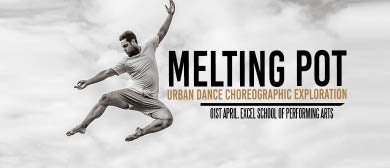Melting Pot: Urban Dance Choreographic Explanation
Excel School of Performing Arts, Auckland
31/03/2017 - 01/04/2017
Production Details
Melting Pot is a showcase of short works using contemporary choreographers and Hip Hop dancers.
This showcase highlights the contrasts of styles, the differences of vocabularies and two worlds colliding to create something interesting, frustrating and exciting.
Melting Pot will showcase new works from Aloalii Tapu, the 2016 recipient of the German Faust prize and named the best dancer in Germany, and Christopher Ofanoa who has been working with the New Zealand Dance Company for the last three years and was a finalist in the Rolex Mentor and Protégé Arts Initiative which took him over to Israel last year.
The journey with these pieces has been interesting and the final product will blow you away.
Hiphop , Dance , Contemporary dance ,
90 minutes
Melting experiments
Review by Carrie Rae Cunningham 03rd Apr 2017
Melting Pot has been described as an “urban dance choreographic exploration.” Members of Freshmans Dance Crew have been paired with two contemporary choreographers to present two new works.
There are actually three pieces in the show – the first is a mash-up hip hop work that I saw Freshmans perform at Aotea Square as part of the Summer in the Square performance series earlier in the year. The format is very much in the style of hip hop competition sets – front-facing, madly fast (and then satisfyingly smooth) syncopated moves to a contemporary urban, funk and soul soundtrack. It’s slick, fun, funny and a joy to watch – a real crowd pleaser with a theatrical twist and a perfect way to warm up the crowd for what may be, for some, an introduction to contemporary dance.
I find it interesting that the contemporary choreographers chosen both have a background in hip hop and street dance as well as contemporary dance. Christopher Ofanoa and Aloali’i Tapu both danced with hip hop crews in their early careers and both attended Unitec where they studied contemporary dance and choreography. Ofanoa has had considerable experience performing a wide range of contemporary dance pieces with The New Zealand Dance Company, and Tapu has been working extensively in Berlin with renowned European contemporary choreographers.
Also interestingly, the two works by these choreographers are quite similar in many ways.
Both Ofanoa’s Psyche and Tapu’s An Ode To Auntsui have: 1) recurring choreographic themes of many dancers encircling one dancer who initiates a section of movement, 2) a considerable amount of floor work (that unfortunately I was unable to see from my seat in the fifth row) and 3) content that is either driven or controlled by the particular music selections.
The first observation may just be a fluke. Or perhaps it’s derived from the ideas behind both works that reference looking into the individual’s subconscious (Ofanoa) or delving into one’s memories, either real or imagined (Tapu). There seems to be one thought or memory that drives the rest of the group to move and explore how that thought manifests as a collective movement sequence.
The second observation may be explained by the “contemporary dance” component of the show. We love to roll around on the floor! And this is not an insult in any way – it’s just part of what we do. To be one with gravity, to explore level changes, to feel how our entire bodies in contact with the floor is different – and creates different movement qualities – than when we’re on two feet. It’s also in direct contrast to the stylised, upright movement vocabulary that is typically (although not always, I know) associated with hip hop and street dance, particularly competition-based sets and routines. I’m sure it was used in a very direct and meaningful way, but I couldn’t see anything from where I was sitting.
The third observation immediately makes me think of how, as humans, we are primitively and intrinsically impelled to move by rhythm – again, a sweeping generalisation! But one I’m prepared to defend if challenged. Also – hip hop and street dance have that direct link to movement choices through beats and musicality – this informs breaking styles such as popping, locking, tutting, b-boy and the myriad of other dynamic styles that have evolved from the growing art form of street dance. I could clearly see the dancers were all very accomplished in these various styles.
The programme notes state, “This showcase highlights the contrast of styles, the differences of vocabularies and two worlds colliding to create something interesting, frustrating and exciting.” I was intrigued by the ‘frustrating’ part, which I read in the programme before the show began. But now I get it.
I give full credit to Hadleigh Pouesi and Freshmans Dance Crew for taking on the challenge to bring the dancers together with these choreographers. The dancers embraced the opportunity to try something new and step outside their comfort zones, but I think they can go further (was it really that far outside?) – both in terms of pushing the boundaries of how they move and who they choose to direct them as choreographers. I highly encourage them to keep experimenting and finding new ways of moving and responding to each other in space and time. It’s a big world out there.
Copyright © in the review belongs to the reviewer





Comments